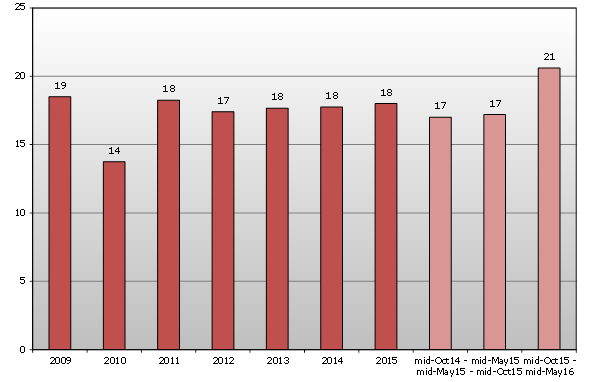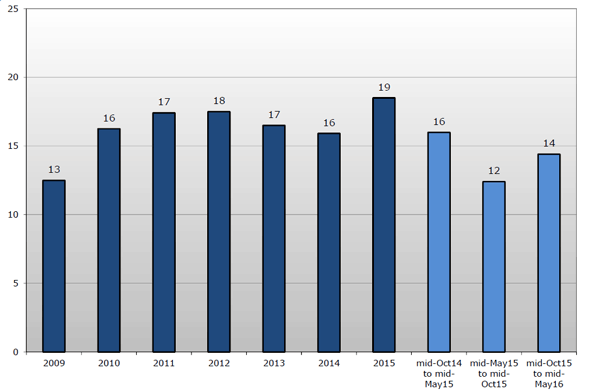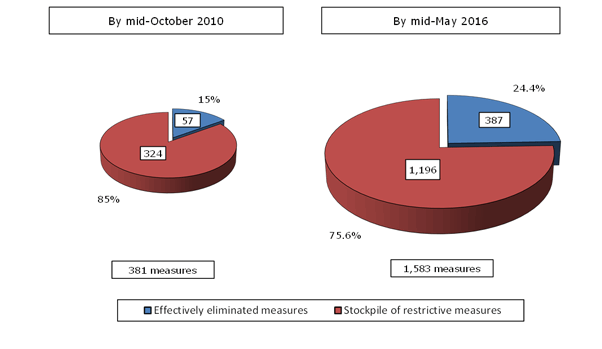MORE:
In the period under review (mid-October 2015 to mid-May 2016), G20 economies applied 145 new trade-restrictive measures, or an average of almost 21 new measures a month. In the same period, G20 economies implemented 100 measures aimed at facilitating trade, averaging just over 14 per month. Since 2009, a total of 1,583 trade restrictive measures were imposed by G20 countries, and only a quarter of these measures have been removed. These restrictions cover over 6% of all G20 imports and 5% of global imports.
Commenting on the report, WTO Director-General Roberto Azevêdo said:
“We have long been concerned about the growing stockpile of trade-restrictive measures, and our report suggests that this worrying trend is continuing. A rise in trade restrictions is the last thing the global economy needs today, with GDP growth sluggish and 2016 expected to be the fifth year in a row that trade has expanded by less than 3%.
“These trade-restrictive measures, combined with a notable rise in anti-trade rhetoric, could have a further chilling effect on trade flows, with knock-on effects for economic growth and job creation. If we are serious about addressing slow economic growth then we need to get trade moving again, not put up barriers between economies. The G20 economies have made a commitment to lead in this endeavour as the world’s largest traders. I urge them to act on this commitment.”
The main factor behind the rise in trade-restrictive measures was an increase in the number of trade remedy investigations by G20 economies. Anti-dumping actions account for the majority of restrictive measures imposed, with most of the investigations concentrated in sectors such as metals (particularly steel) and chemicals. G20 members also imposed more distortive measures in the form of government support for sectors such as infrastructure, agriculture and export-specific activities.
On a positive note, WTO members are using the forums provided by the organization to address potential trade frictions constructively and transparently, rather than through dispute settlement or resorting to unilateral measures. This underlines the importance of the WTO as a platform for addressing such concerns.
The G20 economies are Argentina, Australia, Brazil, Canada, China, France, Germany, India, Indonesia, Italy, Republic of Korea, Japan, Mexico, the Russian Federation, Saudi Arabia, South Africa, Turkey, the United Kingdom and the United States, as well as the European Union.
Key findings
- In the review period between mid-October 2015 and mid-May 2016, G20 economies applied 145 new trade-restrictive measures, equating to an average of almost 21 new measures per month. This indicates a significant increase compared to the previous reporting period at 17 per month.
- This is the highest monthly average registered since the beginning of the monitoring exercise in 2009 which helps explain that the overall stockpile of restrictive measures introduced by G20 economies grew by 10% during the review period.
- Of the 1,583 trade-restrictive measures, including trade remedies, recorded for G20 economies since 2008 by this exercise, only 387 had been removed by mid-May 2016. The total number of restrictive measures still in place now stands at 1,196.
- Although some G20 economies have been eliminating trade restrictions, the rate by which this is done remains too low to dent the stockpile of such measures. Of the total number of trade-restrictive measures recorded for G20 economies since 2008, the share of eliminations, or roll-back, make up less than 25%.
- The report also finds that during the reporting period a total of 100 measures aimed at facilitating trade were taken - a monthly average of 14 measures. This represents an increase compared to the previous reporting period, but remains below the average trend observed since 2010.
- At the same time, the number of trade remedy investigations initiated by G20 economies has increased during this reporting period, representing 61% of trade restrictive measures, a share that remained slightly higher than the average share observed since 2009.
- General economic support measures implemented by G20 economies appear on the rise. The review period recorded a monthly average of such measures comparable with the number recorded immediately after the onset of the global financial crisis.
- World trade remained volatile in 2015 as diverging outlooks for developed and developing economies unsettled global financial markets and prompted sharp movements in commodity prices and exchange rates. The volume of world merchandise trade grew 2.8% last year as trade fell sharply in the first half of the year before recovering in the second half.
- Prospects for world trade in 2016 and beyond remain uncertain. The most recent WTO trade forecast of 7 April 2016 predicted merchandise trade volume growth of 2.8% in 2016, unchanged from 2015. Despite a number of positive developments, the global environment remains challenging and continued vigilance is required.
- In the midst of this uncertainty, G20 economies must lead by example in the fight against protectionism by rejecting new trade-restrictive measures and rolling back existing ones.
- The WTO will continue to monitor trade policy trends and developments in the G20 economies and provide a transparent and predictable platform for addressing the challenges facing the global trading system today.
G20 trade-restrictive measures
(average per month)
Note: Values are rounded.
Source: WTO Secretariat.
G20 trade-facilitating measures
(average per month)
Note: Values are rounded.
Source: WTO Secretariat.
Stockpile of trade-restrictive measures
Source: WTO Secretariat.
> Problems viewing this page?
Please contact [email protected] giving details of the operating system and web browser you are using.



